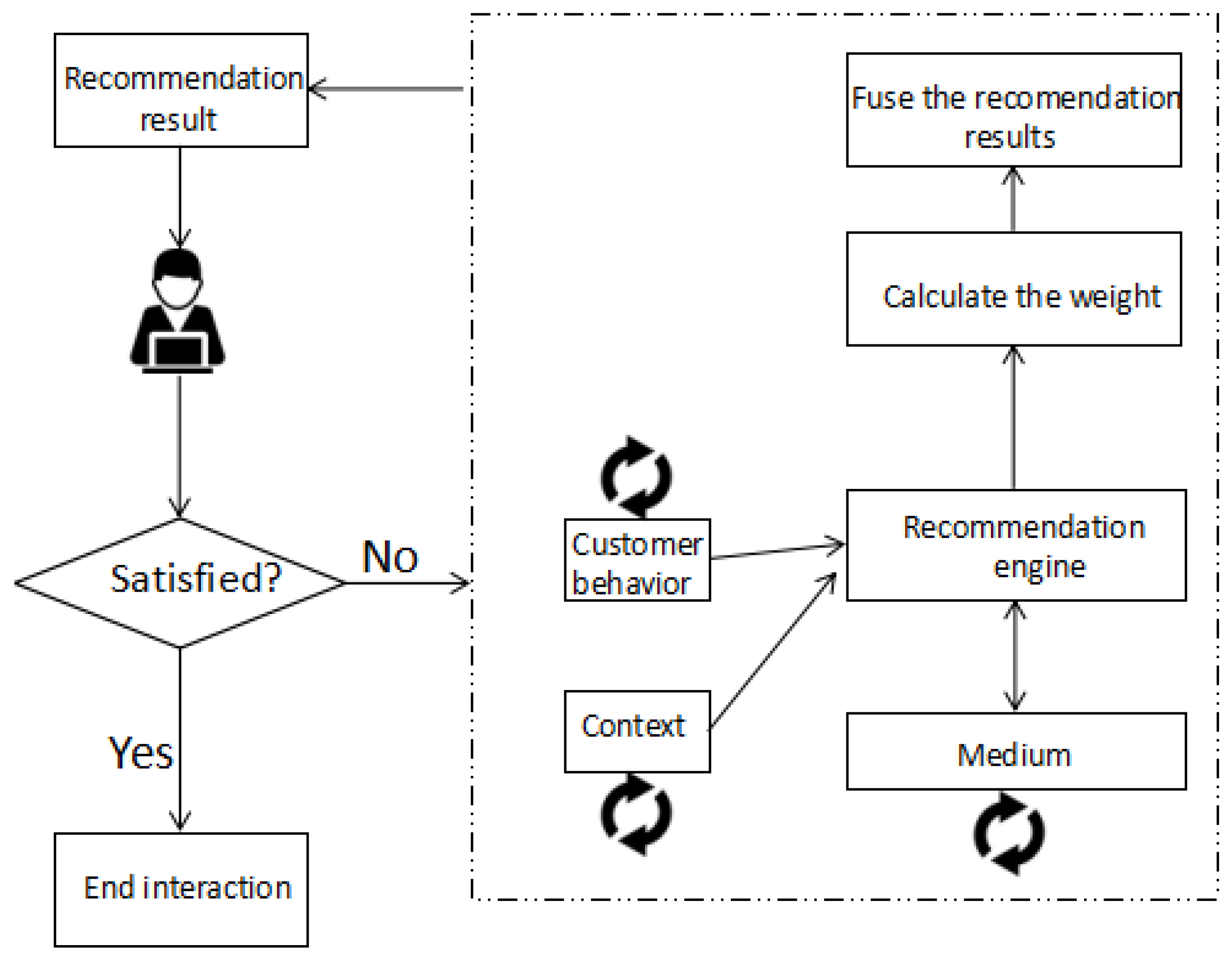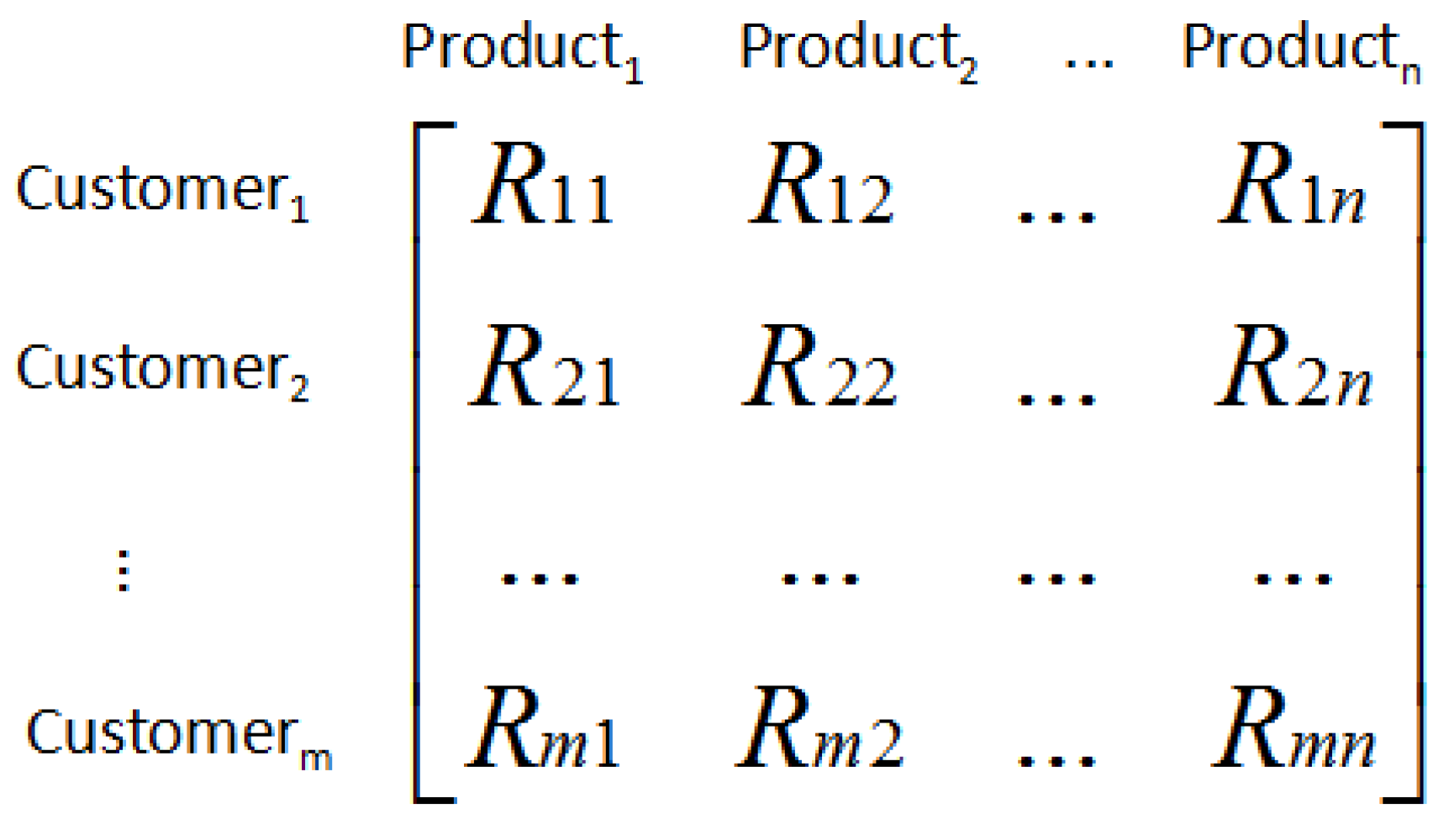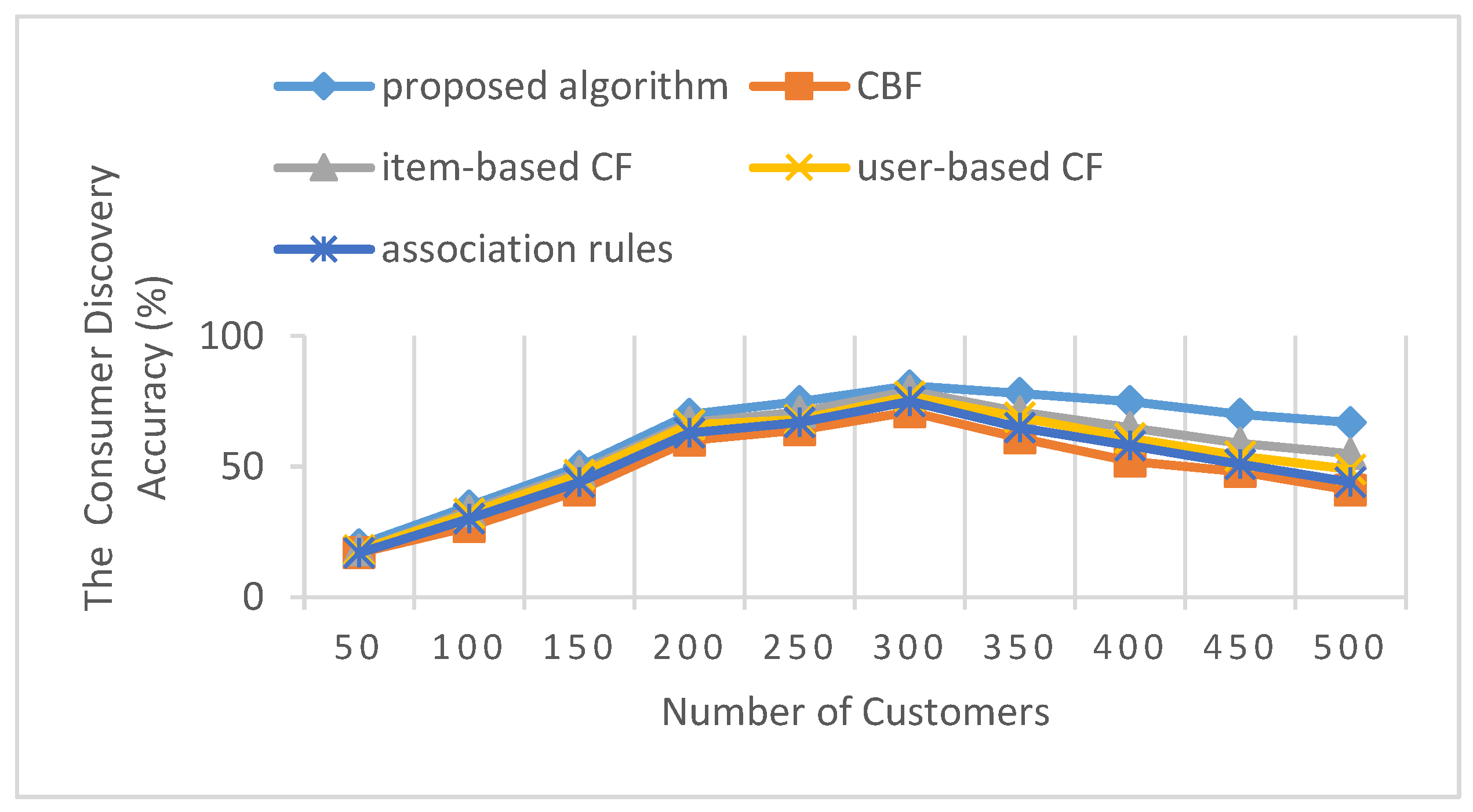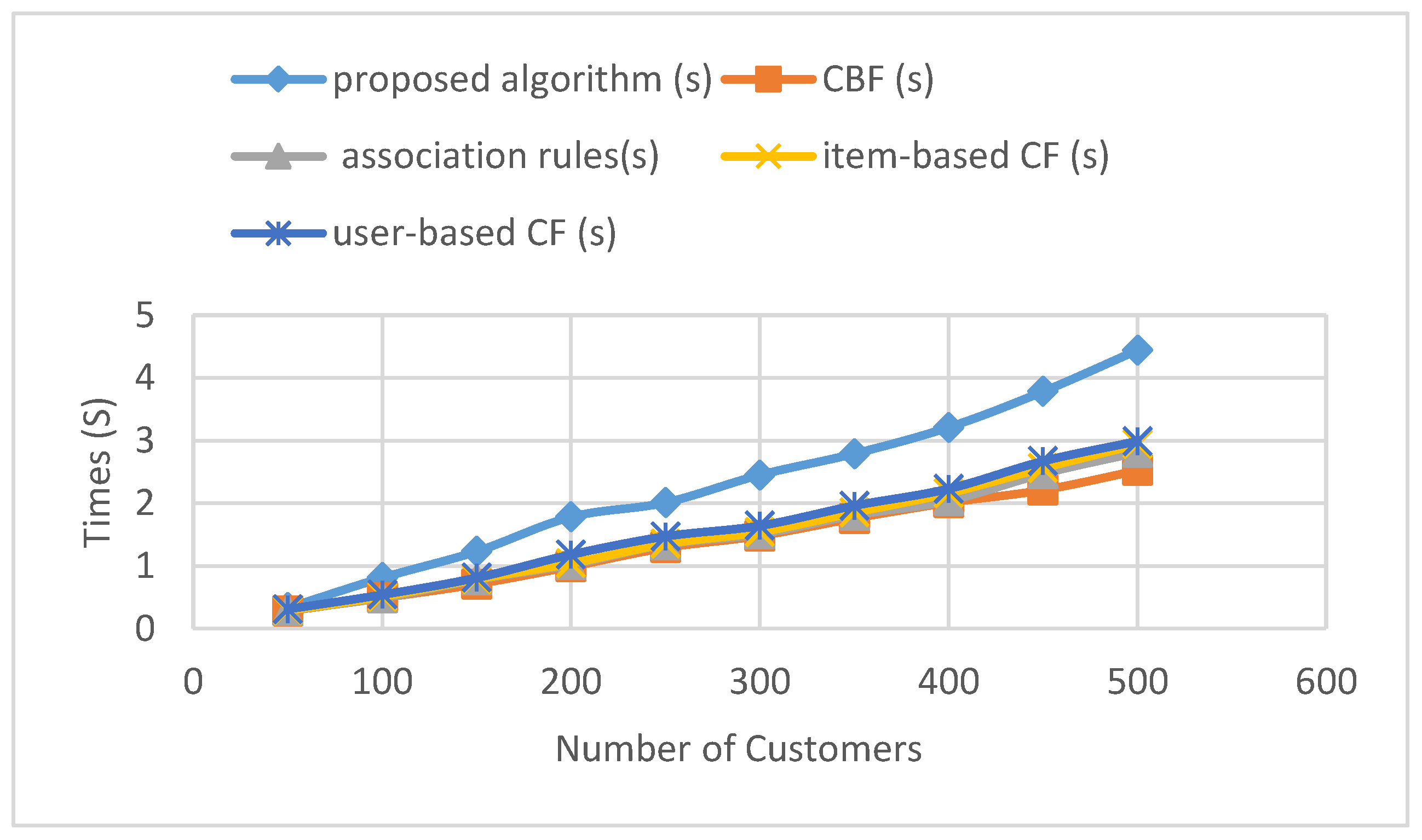3.1. The Solution Framework
To construct an interactive recommendation system based on a hybrid algorithm of multiple recommendation algorithms, we followed the framework as outlined in
Figure 1. The first phase is to preprocess the information of products and consumers, where retaining useful information and building relationships are the main tasks. The second phase obtains original recommendation results through various recommendation algorithms. The third phase calculates the weights for each result. A weight measures the importance of a recommended result. The fourth phase is to get the final recommendation results through fusing the original results of various recommendation algorithms. The last phase is to show the recommendation results to the customer through an interactive interface, and record the customer’s feedback information to correct the recommendation weights. Details are described next.
We propose a new method to enable customers to interact with recommendation systems and to create a feedback loop that incorporates customer feedback and input. Detailed description about the process of interactive interface and procedures with customers is shown in
Figure 2. The customer-behavior node refers to the customer’s current browsing/search products, click, evaluation and so on, which is used as a basis for calculating personalized recommendations. The information such as time, location and weather is denoted by the context node. The recommendation engine node gets the information from the customer behavior node and the context node to calculate the data for the medium node. The medium node represents data inferred from customer behavior and context data by the recommendation engine: a list of customers that are similar to the active customer is a typical example of such data.
The interactive process is illustrated by the arrows in
Figure 2. The straight arrows indicate the data flow, while the revolving arrows refer to customer interactions with data elements of the different nodes. For instance, the revolving arrow of the customer behavior and context nodes represents interaction of customers with an interactive interface that represents customer behavior and context data, respectively. The revolving arrow of the medium node represents interaction of customers with an interactive interface of medium data, such as a list of like-minded customers. Customer feedback through the three nodes is transmitted to the recommendation engine through the straight arrows pointing towards the recommendation engine node. Then, the engine recalculates the weight and transmits the revised data to the medium and the recommendation result to the interactive interface. If the consumer is satisfied with the recommendation result, the interaction is ended. Otherwise, the interactive loop continues.
3.2. Obtain the Recommendation List
Obtaining the recommendation list requires three elements: products, customers and recommendation algorithms. The system mines customers’ interest portraits from multiple dimensions, and precisely pulses customers’ preference. Meanwhile, the system processes the products’ information and gets the relation between the products. According to the needs of each recommendation algorithm, the system handles related information as the basis for subsequent analysis.
is a collection of all customers, and
is a collection of all the products. The utility function
is used to calculate the recommendation degree of the product
to the customer
. The goal of the recommendation algorithm is to find the product
that has the maximum recommendation degree. The formula is as follows:
3.2.1. CBF Algorithm
The CBF algorithm takes the feature as the basic unit to describe the product. It extracts features from customers’ data and builds the customer preference model
. Then, according to the location and frequency of different features in the product, it determines the match extent between the predicted product and the customer preference. The utility function can be calculated as follows:
where
is the similarity calculation, which can be calculated by Euclidean distance, Pearson similarity, vector cosine angle and so on. The object of the algorithm is mostly described by the text of the product, and the recommendation process does not require customer intervention. Therefore, it is a real-time process.
3.2.2. CF Algorithm
The CF algorithm, one of the most widely used techniques in recommendation systems, is based on a group of customers with the same interest [
42]. CF uses the matrix of customers and products shown in
Figure 3 to find the similarity between customers and products. Then, it combines the customer’s historical information to obtain the recommendation degree of the product, and produces the recommendation result according to the recommendation value. CF can be divided into two types: user-based CF and item-based CF.
The specific idea of user-based CF is as follows. (1) Calculate the similarity
between the customer
and the other customers by using the customer’s score for the product as a vector to determine the customer
preference similarity
; (2) obtain the utility value of the customer
to the product
by the weighted average of the similarity
and the similarity of the customer
. Therefore, the utility function is
Item-based CF is based on the following assumptions: Products that attract customers’ interest must be similar to products that have been rated high previously. According to the hypothesis, calculate the similarity between the product evaluated by the customer , and the predicted product . Then, obtain the utility value of the customer to the product by the weighted average of the similarity and the score of the customer to the product . Therefore, the utility function is
The difference between the CBF algorithm and the CF algorithm is as follows: When mining the relationships among projects, the CBF algorithm needs no customer information except for the characteristics of the products. The item-based CF algorithm determines the relationship among the products using the customers’ score.
3.2.3. Association Rules-Based Algorithm
The essence of recommendation based on association rules is to extract the relationship among products in a data set [
43]. The recommendation algorithm has two key elements:
and
, where
is a product to be predicted. Support is an important basis for data pruning, while confidence reflects the link between the product
and customer-interested product
, that is, the measure of utility value.
This article takes the above four common recommendation algorithms as an example to form factors of a hybrid recommendation strategy. Through the above four algorithms, the corresponding results are obtained, which are the preparations for the following fusion recommendation results.
3.3. Measure the Weights of Each Recommendation Result
After recommendation results of four algorithms are generated, the next step is to determine the weights of the corresponding results. In decision analysis, different results have different importance, and they play different supporting roles in our decision making. The weight of the original recommendation result is closely related to the accuracy of the final recommendation result. If the result of a recommendation algorithm has higher accuracy, then the algorithm should be more reliable and have greater weight in the decision process. For recommended data sources
,
, the importance of a subset of non-null conditional attributes
is:
where
is the classification accuracy of attributes set
relative to class attributes
, and
describes the impact of deleting attributes subset
on the classification of conditional attributes. The greater the impact, the more important the attribute subset.
The recommendation capabilities of the recommendation algorithms are different under different situations. Therefore, the weights should be different in the personalized recommendation process. A recommendation algorithm is given the basis of the distribution of credibility, that is, the rule condition consists of a subset of conditional attributes. The weight of the result is
Key steps of the method for determining weights are outlined below.
- Step 1.
Let be the set of all input attributes in recommended data sources , and let be the real recommended products. is the number of recommendation algorithms.
- Step 2.
Train the neural network to maximize the network accuracy with as input and as output.
- Step 3.
For , let be a network whose connection weights are as follows:
- (a)
For all the inputs except , assign the connection weights of equal to the weights of .
- (b)
Set the connection weights of
to zero.
Compute the output of network .
- Step 4.
Compute the influence of to the network accuracy.
- Step 5.
If , go to Step 6, otherwise, set and go to Step 3.
- Step 6.
The derived are the weights of the recommendation algorithms.
In the above step, we first find a trained neural network with the entire set of attributes , , as its input. For each recommendation algorithm, suppose the condition attributes consists of , . We calculate the prediction result of the neural network after deleting , as described in Step 3. That is, the connection weights of the are set to 0, and the connection weights of other attributes are the same as those of the trained neural network . Then, compute the output of network , whose connection weights are stated as above. Last, as Step 4 says, compare the difference of accuracy between network and . The difference of accuracy can be regarded as the influence of the algorithm on the result. The greater the influence of the attribute set on the result, the bigger is its weight.
3.4. Fuse the Results
Through the acquisition of recommendation results and their importance, we obtain the representation of the recommendation scheme as follows:
where
,
is the target consumer,
is the one recommendation algorithm,
is the weight of
,
is the recommended target product, and
is the basic credibility that
thinks
buys
. If every recommendation algorithm gives different recommendation results, how do you recommend products to consumers at this time? In this paper, we use the synthetic formula of evidence theory to synthesize the recommendation results to form the final recommendation scheme. It realizes the product recommendation by using a variety of algorithms.
In the process of information fusion, evidence theory first defines an identifiable framework
to describe
basic assumptions about decision problems. Based on the identifiable framework, we can obtain the dense of underlying assumption, denoted
. The basic idea of evidence theory is that, for a decision object, the basic credibility distribution is given by the conclusion whose concentration is
. The basic credibility assignment is any function as follows:
, and that has the nature:
,
. Given the basic credibility assignment of
, we can obtain the confidence function
and the likelihood function
:
In the framework of traditional evidence theory, the synthesis rule is the most classical and commonly used synthesis method that has the characteristics of commutativity and associativity. The formula is as follows:
where
and
are the basic credibility assignments given by any two evidence sources,
and
are hypotheses about the evidence sources and
stands for the inconsistent information of two evidence sources.
Let us take an example to present the fusion mechanism. Companies are making decisions about which computers are recommended to Lily. We use three algorithms mentioned in
Section 3.2 as the recommendation methods. The three recommended computers are defined as A, B, C. The reliability given by the algorithms is shown in the
Table 2.
After getting a list of recommended products from each recommendation algorithm, we use the method mentioned in
Section 3.3 to obtain the recommendation weights.
Table 3 shows the results of each recommendation algorithm and their corresponding weights.
Evidence theory is used to synthesize the basic credibility assignment. The results are shown in
Table 4. We can get personalized recommendation results from different recommendation algorithms whose results are occasionally conflicting. For example, the recommendation result of algorithm
and algorithm
is B, but the recommendation result of algorithm
is A. Through the fusion of the initial results from each recommendation algorithm, the final result is A (0.658 > 0.656 > 0.577).
By using the proposed method, we get the products that are suitable for the customer. In our example, only three product’s recommendation results are obtained. In real-life transactions, there are thousands of goods in the database. Space for the recommended products is limited. The system can choose the recommended products according to their recommendation probabilities. The recommendation results of the hybrid algorithms are shown to the consumer through the interactive interface. Then, according to the feedback behavior of the consumer, the weight of each result in
Section 3.3 is changed dynamically. Furthermore, the original results are re-fused until the final results are optimal.












